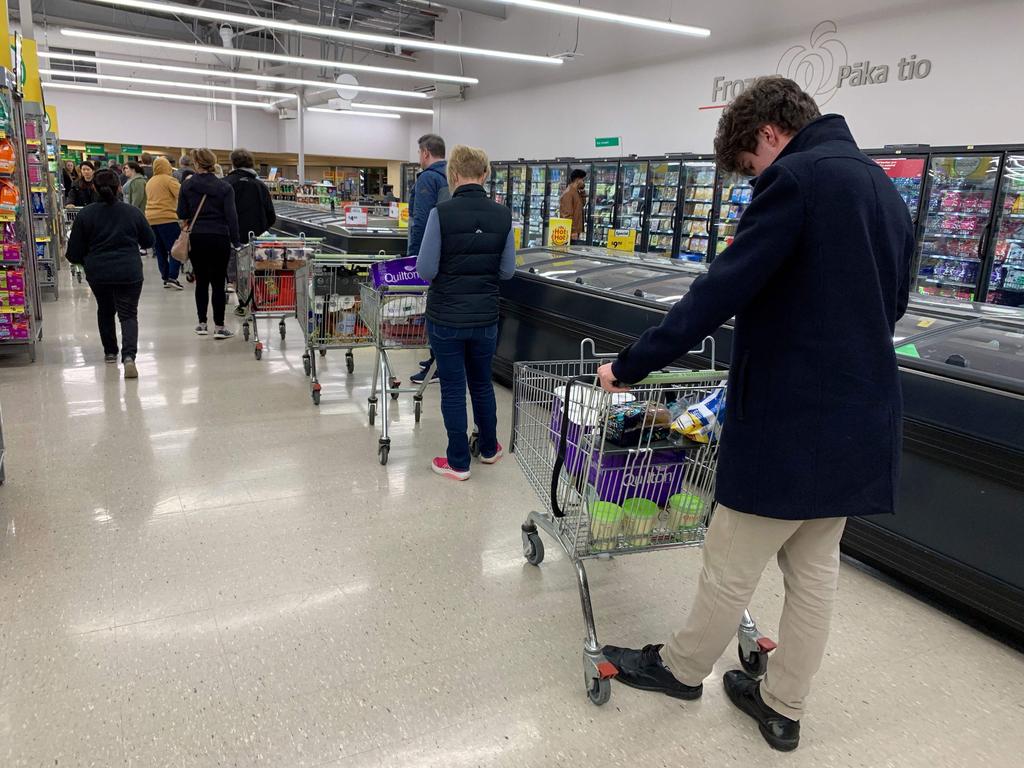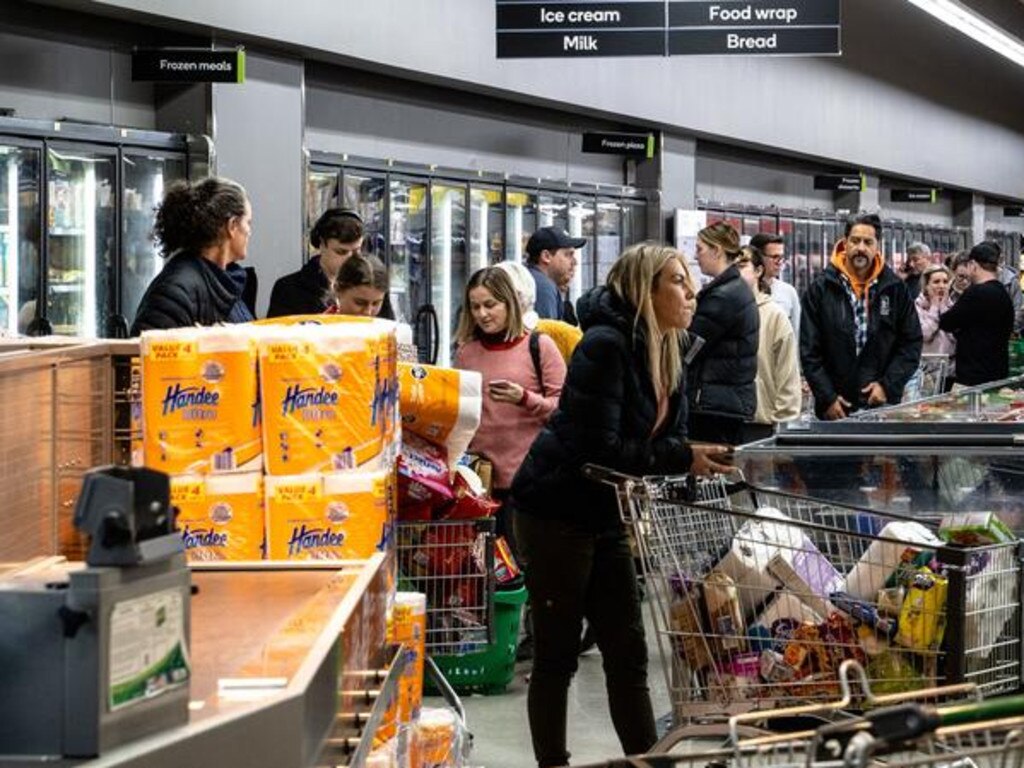New Zealand lockdown: Panic buyers queue at Auckland supermarkets
Chaotic scenes have unfolded in New Zealand as panic-stricken shoppers rip open supermarket doors before lockdown begins.
Supermarkets aren’t even closing but shoppers are still going nuts in Auckland after New Zealand confirmed four new coronavirus cases sending the nation that thought it had crushed the virus back into lockdown.
Despite New Zealand Prime Minister Jacinda Ardern imploring people not to rush to supermarkets when she announced the return of coronavirus and restrictions in a press conference Monday night, people have not heeded warnings.
But this morning, queues almost a kilometre long have been reported outside supermarkets, after a night of panic-buying caused some stores to close early.
Purchasing limits have now been brought in to prevent stockpiling.
Meanwhile, Air New Zealand will require all travellers flying from Auckland to wear masks.
Footage posted to social media also showed long lines at COVID-19 testing sites this morning.
Ponsonby Countdown - all very calm and ordinary. #covid19 #NZ #level3l9ckdown #Auckland pic.twitter.com/dNjTfGTXD1
— John Dyer-Causton (@JohnDyerCauston) August 11, 2020
We just tried to go get tests for my mum and aunt and well, look at this testing centre at Manukau right now. pic.twitter.com/Pv4zWa8yJx
— Patrick Thomsen (@_PatrickThomsen) August 11, 2020
When Ms Ardern last night announced Auckland would return to level-three restrictions and the rest of the country to level two, residents immediately started posting photos and videos to social media of long queues outside shopping centres.
The panic came as four COVID-19 cases had been diagnosed in one family with no known source.
In the most shocking clip, security guards can be seen trying to control the stream of shoppers forcing their way through the doors of supermarket Countdown in New Lynn. A child is crying as someone tells staff the woman needs food for her child.
The supermarket was forced to close shortly before 10.30pm, an hour and a half early, after it was overrun by the shoppers.
Police are at New Lynn Countdown after people ripped the doors open when security tried to control the amount of people rushing in. That woman is saying she needs food for her kid. This ain’t it Auckland. pic.twitter.com/PDf1Oe26Mx
— Matt Manukia (@MattManukiaTVNZ) August 11, 2020
Just a few moments before. pic.twitter.com/lt6OYo7ran
— Matt Manukia (@MattManukiaTVNZ) August 11, 2020
The city of Auckland will return to stage three restrictions for three days starting from midday (local time) on Wednesday. The rest of the country will return to stage two restrictions for three days.
But even when stage-three restrictions return for Auckland, people will still be able to leave the home for essential services like buying groceries.
“Please do not rush to the supermarket tonight ... there is no reason to rush out and make any purchases this evening,” Ms Ardern said.
“You’ll even be able to get a takeaway coffee.”
Definitely don’t go to the supermarket tonight Auckland people. pic.twitter.com/wTznPfvrWr
— Ricky Wilson (@RickyWilsonVJ) August 11, 2020
Countdown Greenland, Auckland 🙄 pic.twitter.com/s9ELMI8Z0U
— Lorna Subritzky (@lornaexplorernz) August 11, 2020
Ms Ardern said Aucklanders should use masks if they leave the house to access essential services but many were not wearing them tonight or following social distancing measures.
“It was chaos. There was traffic blocking all of the roads leading to the supermarket, the parking lot was completely full and there were cars queued to get into the parking lot,” one Greenland shopper told the NZ Herald.
READ MORE: Putin announces virus vaccine



Countdown’s website was also overwhelmed, warning of “very high demand” on its online shopping service.
New Zealand had been virus free for 102 days until the family cluster was announced last night.
The cases have no known source.
greenlane countdown five minutes ago #covid pic.twitter.com/bYFiTA7s9S
— ⓂⒶⓇⒸⓊⓈ â“ⓊⓈⒽ (@marcuslush) August 11, 2020
The first case confirmed was a person in their 50s who presented to their GP with symptoms yesterday.
Authorities sprung into action and tested the rest of the family.
Of the six other family members tested, three were positive and the others returned negative results.
New Zealand has four confirmed cases of COVID-19 in one family acquired from an unknown source.
— New Zealand Police (@nzpolice) August 11, 2020
🟡 As of midday tomorrow, Auckland will move to Alert Level 3. The rest of New Zealand will move to Alert Level 2 🟡
Find out more https://t.co/Uu9OPs5DL4 pic.twitter.com/7gQk2wenqV
WHAT IS LEVEL THREE?
The entire Auckland region is moving to alert level three for three days to “give us time to assess the situation and gather information, including contact tracing, so we can find out more about how the case arose”.
Here’s that that means.
Work: People are encouraged to work from home if they can.
Travel and self-isolation: Non-residents currently in Auckland are being asked to go home. People are urged to “keep your bubble small”, practise good hygiene and if they have symptoms, get a test.
Businesses: Businesses can open but “should not physically interact with customers”. Bars and restaurants must close but takeaways are allowed. Essential services including healthcare, justice services and businesses providing necessities can remain open.
Education: Schools in Auckland can safely open but will have limited capacity. Where possible students are encouraged to learn from home.
Out and about: People must maintain two metres of physical distancing. Mask wearing is “highly recommended”.
Public transport: Strict health and safety requirements apply, including physical distancing and mask wearing.
Public venues: Libraries, museums, cinemas, food courts, gyms, pools, playgrounds and markets must close.
Gatherings: Gatherings of up to 10 people are allowed but only for wedding services, funerals and tangihanga – traditional MÄori funerals. Physical distancing and public health measures should be maintained.
At-risk people: Older people and those with existing medical conditions are encouraged to stay at home where possible, and take additional precautions when leaving home.




